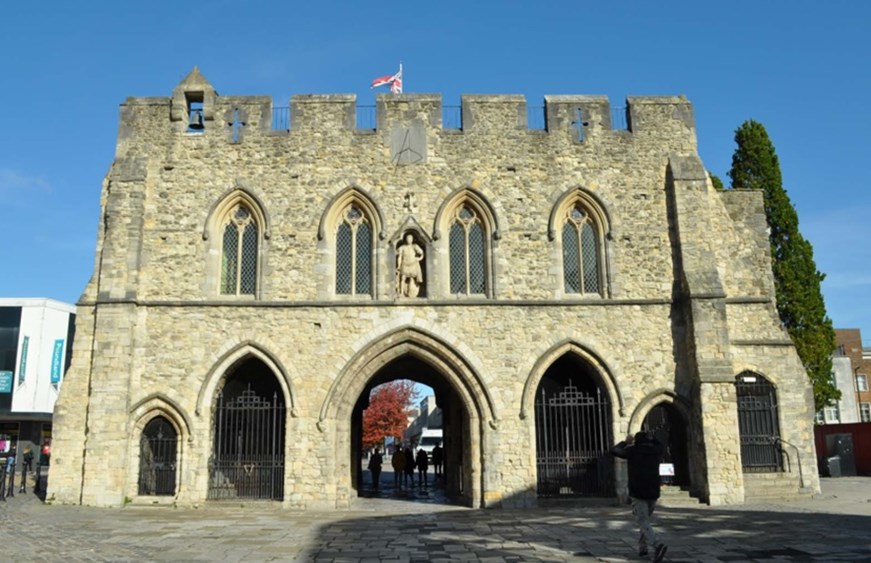Investing in our city's heritage: first phase of Southampton’s conservation project complete
Following Southampton City Council’s commitment to investing in preserving and regenerating many of our important heritage assets, the first phase of works are now complete

The structures are mostly medieval with stone construction varying from the medieval Town Walls, the remains of Southampton Castle, medieval wine vaults and occupied weathertight medieval buildings, including the Bargate and the Westgate. These structures form part of historic Southampton tours, attracting local visitors and tourists to generate economic benefits for the city.
The first phase of repairs started in June and included internal and external repair works to Tudor House to maintain and protect the venue. High profile monuments such as the Town Walls and St Mary’s Churchyard Wall also had repairs. Forty Steps near Western Esplanade were repaired whilst there were roof repairs in Quilters Vault, the Westgate and the Bargate.
The Castle Bailey Wall, next to the car park in Castle Way, benefitted from a range of repairs which included: vegetation treatment and removal, mortar repairs, stonework replacement, sedum capping and rebuilding of existing stonework. The wall was also repointed and given a protective green turf capping which was carefully selected to protect the top of the walls.
The works were carried out in collaboration with the council’s in-house heritage and archaeological experts, external expert advisors and Traditional Stone Restoration. The heritage repair project will ensure these nationally important historical assets will be available for the people of Southampton and visitors from across the globe to enjoy for the decades ahead.
The importance of Southampton’s heritage is well documented with architectural historian, Nikolas Pevsner, famously writing:
“In all Britain there are few, if any, examples of medieval urban defences
as impressive as those in Southampton.” [1]
Councillor Lorna Fielker, Leader of Southampton City Council, said:
“Our heritage buildings and monuments have shaped our city for hundreds of years and play an important part of telling our Southampton story as a gateway to the world.
“We know that many local people and visitors enjoy exploring our town walls, vaults and other monuments, and this programme of repairs will preserve our much-loved heritage for future generations to enjoy and learn from”.
Contractors Traditional Stone Restoration said:
“As stonemasons specialising in the conservation and restoration of old structures and buildings, it is always a privilege to become the temporary custodians of important historic landmarks.
“Phase one of the works provided a myriad of opportunities for our team to enhance and develop their skills, especially for the younger and more inexperienced members some of whom only recently qualified. The local residents and visiting tourists often engaged with the team, showing great interest in the ongoing works and seeking explanations of our techniques especially with the soft capping on the North Bailey wall.
“We have thoroughly enjoyed our time in Southampton working with the council”.
Alex Bellisario, Assistant Inspector of Ancient Monuments at Historic England, said:
“We are delighted to see the continued emphasis Southampton City Council is giving its heritage. We are working with and supporting the council and their conservation architects on this programme of repairs, providing expert advice.
We hope the conservation of these archaeological remains, which tell such a wonderful story of Southampton’s past, will ensure they are protected for hundreds of years to come. We also hope that the investment by the council in these monuments will invigorate interest about the city’s past and its future for those who live and visit here.”
Southampton City Council has a duty under the Ancient Monuments and Archaeological Areas Act 1979 to maintain and provide public access to any monument in its care. Given that 37 of the 41 nationally important Scheduled Monuments in the city are owned and cared for by the council, this is a considerable responsibility that the local authority takes very seriously.
Preparations for the second phase of the project have already begun. Information about the work to date and what’s next in this project can be found online.
Reference:
[1] Nikolas Pevsner and David Lloyd, 1967, The Buildings of England Hampshire and the Isle of Wight, page 533. Repeated word for word in 2018 edition.


